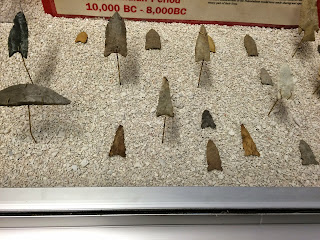This morning began very mild but by 10am a cold front moved in with rain and falling temperatures. From a high of 56 at 9:30 it was 43 by noon. But no matter, we went in search of Reelfoot Lake and the largest earthquake in the history of the eastern U.S.
Lots of farm equipment on the roads in southwestern Kentucky and northwestern Tennessee.
Most of the fields are harvested.
Now its time to prepare the fields for winter wheat or to get a jump on next spring.
This is a Case tractor, not a John Deere. Case equipment seems to be favored in Tennessee.
As we were traveling to find Reelfoot Lake we saw our first fields of cotton, in Tennessee.
Many of the cotton fields look like they have just been harvested. I don't know how they do that; maybe something like harvesting corn. The roads around the fields look as if hundreds of boxes of kleenex have been strewn along the side of the road.
Reelfoot Lake was created when the New Madrid Earthquakes of 1811 and 1812 stuck along the Reelfoot rift, which developed 1.2 billion years ago. In December 1811, the Mississippi valley erupted with the first in a series of the strongest quakes known in eastern North America. Two quakes occurred in December 1811. The third hit in January 1812, while the February 1812 quake became known as "the hard shock."
The four major quakes were each followed by secondary shocks which were as severe as the major quakes. Between the quakes and shocks, the ground continuously moved. A Louisville engineer counted a total of 1,874 shocks between December 1811 and March 1812. The December quakes measured 8.5 on the Richter scale. The fault developing from the quakes ran 28 miles long and 18 miles wide. Over half of the United States felt the quakes' vibrations. The strongest quake, however, occurred on February 7, 1812. This quake measured 8.8 on the Richter scale. The fault developing from this quake measured 46 miles long and 28 miles wide. People in New England and as far south as South Carolina felt the shocks.The February quake's epicenter was so close to New Madrid that it completely destroyed the town. The quakes disrupted the flow of the Mississippi River. The river had become a major highway for travel and several boats were on the river when the quakes hit. More people died on the river than on land because few people lived in the area in 1811.
On December 16, 1811, the force of the quake was centered in the Reelfoot Lake area, which was then a huge cypress forest. The earth's surface rose and sank, huge landslides slid down the bluffs and more than 15,000 acres of forest land sank beneath the level of the Mississippi River. As the land settled, the water poured into the hole and filled the basin to a depth of 20 feet. The resulting Reelfoot Lake became a commercial and recreational mecca for the past 200 years even though silt is now filling the lake and it is only about half of its original size.
Reelfoot Lake State Park in Tiptonville, Tennessee tells the story of the area before the earthquake and after. Here is the entrance to the Visitor Center all decked out for the season; nice.
This area shares the same history of Native American inhabitants as the rest of the Mississippi Valley. Chickasaw Indians lived in this area until the 1820s and hunted and fished the Reelfoot Lake area after the quake.
These points are part of a collection from a local amateur archaeologist and range in time from the Archaic Period to the present.
Nicely presented.
There was also this display of pottery.
The label reads - These pierced and polished stone objects were probably worn as ornaments but their exact function is not known.
Shell beads used for ornamentation.
These large tools were probably hoes used by the Indians that grew corn and other crops during the Mississippian Period.
Ta da -- the local Indians played Chunky!!
"These mushroom shaped objects were used to smooth wet call during manufacture".
Janice McCain has lived in this area all her life. She has been greeting visitors to Reelfoot Lake State Park for 34 years.
At the Visitor Center we watched a DVD about the Lake and the specially made boats built to navigate the very shallow waters, sometimes only 8 - 10" deep. These boats, called Reelfoot Stump Jumpers use both articulated oars, permitting the rower to face forward, and small engines protected by a metal plate from hitting the bottom. Originally boat owners used the motors from the home washing machine in the boat during the week and then returned it to the washing machine for the Saturday washing. We saw Dale Calhoun hand making these boats, out of cypress wood, in the DVD and there was his shop, across the street from the Visitor Center.
This beautiful plant, Janice called it an American Beauty bush, was outside the Center. She said this is the "flower", and the leaves had already fallen and probably the cold weather tonight would freeze the flowers.
Close-up.
Tonight we are in Memphis, at the Graceland RV Park -- yes, that Graceland! More about that later.
























With temperatures like that, keep heading south!! :)
ReplyDelete